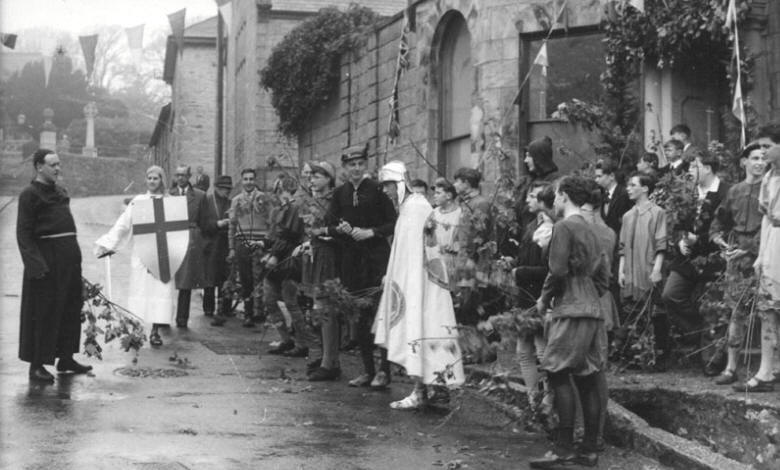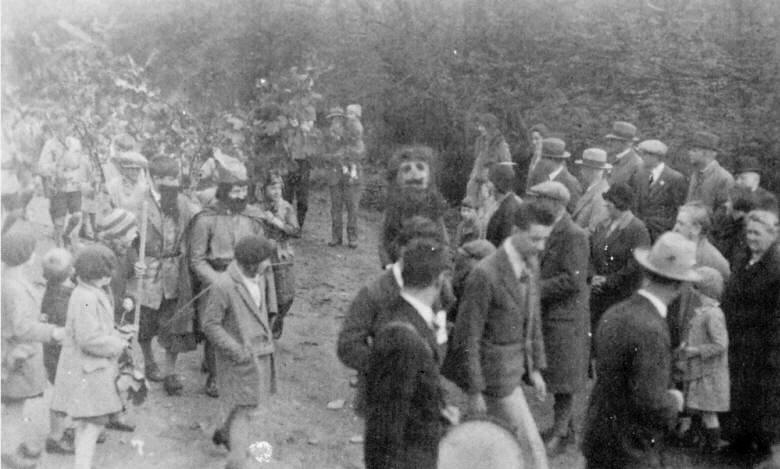|
|
| home | exhibitions | interviews | features | profiles | webprojects | archive |
|
Hal-an-Tow Alan Kent on Helston's 'Flora Day' traditions
The Hal-an-Tow is nowadays posited as a more 'genuine' traditional festival with a more ancient pedigree than the 'modern' gentrified dance traditions found elsewhere on the day. The wider Pagan awakening in Cornwall in the late twentieth and early twenty-first century had seemingly adopted and positioned Hal-an-Tow as a more overtly 'Pagan' event, and in so doing, it has attracted participants and observers of this persuasion. This is one way in which Hal-an-Tow has retained a continuity, but has also adapted to social and spiritual change. This can be seen when we consider the core song related to Hal-an-Tow. There were some slightly earlier small variations but by the middle of the twentieth century, the song had more or less crystallized as being constructed in the following way: Robin Hood and Little John, They both are gone to fair, O And we will go to the merry green wood To see what they do there, O, And for to chase, O To chase the buck and doe. Chorus: Hal-an-Tow, jolly rumble O For we are up as soon as any day, O, And for to fetch the Summer home The Summer and the May, O, For Summer is a-come, O And Winter is a-gone, O. Where are those Spaniards That makes so great a boast, O? For they shall eat the grey goose feather And we will eat the roast, O In every land, O, The Land where e'er we go. Chorus As for that Good Knight, St. George, St. George he was a Knight, O Of all the Knights in Christendom St. George he is the right, O In every land, O, The land where e'er we go. Chorus But to a greater than St. George. Our Helston has a right, O. St. Michael with his wings outspread The Archangel so bright, o Who fought the land, O Of all mankind the foe. Chorus God bless Aunt Mary Moses And all her power and might O, And us peace in Merry England Both day and night, O, And send us peace in Merry England Both now and evermore, O Chorus
However, despite this recognized continuity, Hal an Tow is not so constant a folkloric force as one might first assume. Across the twentieth and twenty-first centuries, there have been some conscious changes made to the song, and consequently, the performance that surrounds it. For example, the verse about St Michael was added in the mid-1930 's by Robert Morton Nance, presumably to connect more directly with one of the core patron saints of Cornwall, and to align the ceremony more specifically with the saint's day of the celebration. Meanwhile, a St Piran verse was added in 2005 because in some quarters it was felt that Hal-an-Tow did not have enough specific Cornish elements within it, and this was emergent at a time post-devolution for Wales, Northern Ireland and Scotland when Cornish nationalism was demanding similar status. The role of St Piran was interestingly assigned to Andrew George, who was Member of Parliament for the St Ives constituency (into which Helston fell) between 1997 and 2015. George was well known for his pro-Cornish views and sympathy for political Cornish nationalism.The criticisms of the old version of the song were based on two factors: that St George was now popularly seen as the patron saint of England and therefore inappropriate for Cornwall, and that the song contained too many instances of an ideology of 'merry England'. To an extent, this criticism and the subsequent rewrites may be termed as difficult in folkloric terms since St George was long celebrated as a pan-British figure. Also, although the concept of 'merry England' may have been deemed an anathema and unpalatable for modern sensibilities in Cornwall, earlier in history, Cornwall's separate but accommodated status was well known within this construct. Therefore, one must ask if such a politicization of the song was indeed the correct thing to do. In its current formalization, the Aunt Mary Moses verse is only performed at the first location, at St John's Bridge, and the last location, by the Guildhall. The words of the Hal-an-Tow, as it is currently sung in Helston, are: Robin Hood and Little John, They both are gone to fair, O And we will go to the merry green wood To see what they do there, O, And for to chase, O To chase the buck and doe. Chorus: Hal-an-Tow, jolly rumble O For we are up as soon as any day, O, And for to fetch the Summer home The Summer and the May, O, For Summer is a-come, O And Winter is a-gone, O. Where are those Spaniards That make so great a boast, O? For they shall eat the grey goose feather And we will eat the roast, O In every land, O The land where-e'er we go. Chorus St Piran showed his care for us And all our sons and daughters, O He brought the book of Christendom Across the western waters, O And taught the love of Heaven above For Cornishmen below Chorus As for that good knight, St George St George he was a Knight, O Of all the knights in Christendom St George he is the right, O In every land, O The land where-e'er we go. Chorus But to a greater than St George Our Helston has a right, O St Michael with his wings outspread, The archangel so bright, O Who fought the fiend, O Of all mankind the foe. Chorus God bless Aunt Mary Moses And all her power and might, O And send us peace in merry England Both day and night, O And send us peace in merry England Both now and ever more, O.
Both versions of the song offer us a composite of the folkloric history of the west of Cornwall. It is possible that the song had earlier versions, but the survival of the Robin Hood and Little John material would seem to correlate with much that we know about the festive performance history in Cornwall, particularly after the declines in the mystery and miracle plays: that seemingly, such Mummer's plays or interludes about the forest-dwelling hero were very fashionable. A trace of that remains here. The green wood itself stands folklorically as a place of inversion, dissension and rebellion because woods and forests were less subject to rules and regulations. There may well even be a trace of the notion of forests being Pagan places, which were part of the original faith of the populace of Britain. We note too the integration of hunting imagery and presence of deer within the narrative. This seems apt, for venison was a much valued foodstuff. There are other earlier noteworthy narratives from Cornwall with a Celtic background, which also make much of the skill of hunting, for example, the various versions of Tristan and Yseult.
Alan Kent is author of 'The Festivals of Cornwall' newly published by Redcliffe, from which this extract is taken. The images are of the Hal-an-Tow in 1950s (above) and 1930s (top) |
|
|


